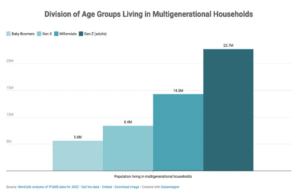Defying the longstanding tradition of “flying the nest,” a staggering 68% of young Gen Z adults are opting for the comforts of familial homes over independent living. RentCafe published a report that takes a closer look into the generations that are choosing to live at home for the foreseeable future. This trend, mirrored by 20% of Millennials who still live with their parents, weaves a nuanced narrative entwining economic, social, and familial bonds in contemporary America. The implications for our society, economy, and the individuals involved are profound. Delving into the data reveals a story of generational adaptation, financial pragmatism, and evolving familial structures that are reshaping the very essence of the American Dream.
In RentCafe’s analysis, it becomes evident that approximately 14 million Millennials and 23 million Gen Z-ers have chosen to share a household with at least one family member. These figures stand as the largest generational shares across all age groups. Among the 51 million people residing in multigenerational households today, 8 million belong to Gen X, while 6 million are Baby Boomers. This data unveils a significant societal shift, highlighting the prevalence of multigenerational living and its impact across various age cohorts.

The variance between generations in housing choices can be attributed to several factors. Younger generations may find it more enticing to continue residing in their parental homes, driven by the desire to save money on various expenses, including childcare costs, utility bills, rent, or a future down payment. Additionally, an increasing number of Millennials and Zoomers might opt to stay at home to provide care for family members.
Interestingly, California emerges as the epicenter of multigenerational living trends. Among the vast population of approximately 3 million Millennials in Los Angeles, 35% choose to live with family members. For Zoomers, this percentage rises significantly to 81% of the roughly 1.3 million in this cohort. The prevalence of multigenerational living in these West Coast metros can be attributed to the high cost of living, which stands at 51% above the national average. This economic reality makes it challenging for many young adults to transition away from this living arrangement.

Departing from the parental nest remains a multifaceted issue influenced by factors such as employment opportunities, the cost of living, and personal preferences. Despite an overarching trend toward a decrease in multigenerational living, certain metro areas and demographics defy this pattern. This phenomenon reflects a complex interplay of economic, social, and familial dynamics. Understanding these motivations is crucial for policymakers, urban planners, and businesses as they navigate the evolving landscape of housing preferences and family structures.
A Trusted Guide in Commercial Real Estate
Coldwell Banker Commercial® provides Commercial Real Estate Services from Property Sales and Leases, to Property Management. Learn how our expansive network of Independently Owned and Operated Affiliates and Real Estate Professionals use their in-depth knowledge of the local market and industry trends to help businesses and investors navigate the complexities of the commercial real estate landscape.




